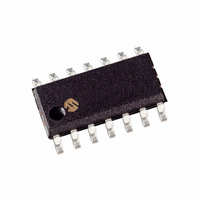HCS473T/SL Microchip Technology, HCS473T/SL Datasheet - Page 5

HCS473T/SL
Manufacturer Part Number
HCS473T/SL
Description
IC KEELOQ 3AXIS TRANSCODR 14SOIC
Manufacturer
Microchip Technology
Series
KEELOQ®r
Type
Code Hopping Encoder and Transponderr
Specifications of HCS473T/SL
Applications
Access Control Systems
Mounting Type
Surface Mount
Package / Case
14-SOIC (3.9mm Width), 14-SOL
Lead Free Status / RoHS Status
Lead free / RoHS Compliant
1.0
The HCS473 combines the patented K
hopping technology and bi-directional transponder
challenge-and-response security into a single chip
solution for logical and physical access control.
The three-input transponder interface allows the com-
bination of three orthogonal transponder antennas,
eliminating the directionality associated with traditional
single antenna transponder systems.
When used as a code hopping encoder, the HCS473 is
well suited to keyless entry systems; vehicle and
garage door access in particular. The same HCS473
can also be used as a secure bi-directional transponder
for contactless authentication. These capabilities make
the HCS473 ideal for combined secure access control
and identification applications, dramatically reducing
the cost of hybrid transmitter/transponder solutions.
1.1
1.1.1
The following is a list of key terms used throughout this
data sheet. For additional information on terminology,
please refer to the K
(TB003).
• AGC - Automatic Gain Control.
• Anticollision - A scheme whereby transponders
• Button Status - Indicates what button input(s)
• Code Hopping - A method by which a code,
• Code word - A block of data that is repeatedly
• Crypto key - A unique and secret 64-bit number
• Decoder - A device that decodes data received
• Decryption algorithm - A recipe whereby data
• Device Identifier - 16-bit value used to uniquely
• Encoder - A device that generates and encodes
2002 Microchip Technology Inc.
in the same field can be addressed individually,
preventing simultaneous response to a command
(Section 3.2.1.4).
activated the transmission. Encompasses the 4
button status bits S3, S2, S1 and S0 (Figure 3-2).
viewed externally to the system, appears to
change unpredictably each time it is transmitted
(Section 1.2.3).
transmitted upon button activation (Figure 3-2).
used to encrypt and decrypt data. In a symmetri-
cal block cipher such as the K
the encryption and decryption keys are equal and
will therefore be referred to generally as the
crypto key.
from an encoder.
scrambled by an encryption algorithm can be
unscrambled using the same crypto key.
select one of multiple transponders for communi-
cation.
data.
GENERAL DESCRIPTION
System Overview
KEY TERMS
EE
L
OQ
introductory Technical Brief
EE
L
OQ
algorithm,
EE
L
OQ
code
Preliminary
• Encryption Algorithm - A recipe whereby data is
• IFF - Identify Friend or Foe, a classic authentica-
• Learn - Learning involves the receiver calculating
• Simple Learning
• Normal Learning
• Secure Learn
• LF - Low Frequency. For HCS473 purposes, LF
• Manufacturer’s code – A unique and secret 64-
• Proximity Activation - A method whereby an
• PKE - Passive Keyless Entry.
• RKE - Remote Keyless Entry.
• Transmission - A data stream consisting of
• Transcoder - Device combining unidirectional
• Transponder - A transmitter-receiver activated
scrambled using a crypto key. The data can only
be interpreted by the respective decryption algo-
rithm using the same crypto key.
tion method (Section 3.2.3.3).
the transmitter’s appropriate crypto key, decrypt-
ing the received hopping code and storing the
serial number, synchronization counter value and
crypto key in EEPROM (Section 5.1). The
K
strategies to be implemented on the decoder. The
following are examples of what can be done.
The receiver uses a fixed crypto key, common to
all components of all systems by the same manu-
facturer, to decrypt the received code word’s
encrypted portion.
The receiver uses information transmitted during
normal operation to derive the crypto key and
decrypt the received code word’s encrypted por-
tion.
The transmitter is activated through a special but-
ton combination to transmit a stored 60-bit seed
value used to derive the transmitter’s crypto key.
The receiver uses this seed value to calculate the
same crypto key and decrypt the received code
word’s encrypted portion.
refers to a typical 125 kHz frequency.
bit number used to generate unique encoder
crypto keys. Each encoder is programmed with a
crypto key that is a function of the manufacturer’s
code. Each decoder is programmed with the man-
ufacturer code itself.
encoder automatically initiates a transmission in
response to detecting an inductive field
(Section 3.1.1.2).
repeating code words.
transmitter capabilities with bi-directional authenti-
cation capabilities.
for transmission by reception of a predetermined
signal.
EE
L
OQ
product family facilitates several learning
HCS473
DS40035C-page 3














